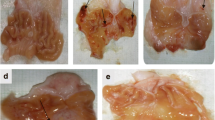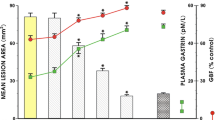Abstract
Alkyl sulfhydryl drugs protect against acute gastric hemorrhagic mucosal lesions. We tested the protective effect of cyclic drugs containing oxidized (KT1-32, KT1-39, KT1-94), or reduced (KT1-66, KT1-109, KT1-293, KT1-720, KT1-756) sulfhydryls. The most potent protective agents (KT1-32, KT1-109, KT1-720, KT1-756) were investigated in detail. Drugs were administered intragastrically to fasted rats 30 min before 100% ethanol (1 ml) or acidified aspirin (10 mg/100 g), and mucosal lesions were measured planimetrically 1 hr later. Control rats receiving only ethanol had lesions involving 14.5% of the glandular mucosa. KT1-32, KT1-109, KT1-720, or KT1-756 (10 mg/100 g) reduced lesions to 0.7, 2.7, 1.8, or 0.7% of glandular stomach respectively. Aspirin-induced lesions involved 1.52% of the glandular mucosa and 10 mg/100 g of KT1-32, KT1-109, or KT1-720, or 2 mg/100 g of KT1-756 diminished the damage to 0.13, 0.02, or 0.04, or 0.00%, respectively. Indomethacin interfered with protection against ethanol by KT1-109, while the sulfhydryl alkylator N-ethylmaleimide abolished protection by both KT1-32 and KT1-109. Among the drugs investigated in detail, KT1-756 increased gastric acid output, while KT1-720 and KT1-756 significantly enhanced pepsin secretion. All four compounds studied in detail (ie, KT1-32, KT1-109, KT1-720, KT1-756) decreased the extent of vascular lesions in the gastric mucosa as revealed by monastral blue 1 min after ethanol. Thus, the mechanism of gastric mucosal protection by these novel aryl sulfhydryl compounds cannot be ascribed to an antisecretory effect, but may be related to prevention of vascular injury.
Similar content being viewed by others
References
Morson BC, Dawson IMP: Gastrointestinal Pathology. Oxford, Blackwell Scientific, 1972, p 80
Lev R, Kawashima K, Glass GB: Morphologic features and healing of stress ulcers induced by alcohol and restraint. Arch Pathol Lab Med 100:554–558, 1976
Hingson DJ, Ito S: Effect of aspirin and related compounds on the fine structure of mouse gastric mucosa. Gastroenterology 61:156–177, 1971
Robert A: Cytoprotection by prostaglandins. Gastroenterology 77:761–767, 1979
Robert A, Nezamis JE, Lancaster C, Hanchar AJ: Cytoprotection by prostaglandins in rats. Prevention of gastric necrosis produced by alcohol, HCl, NaOH, hypertonic NaCl, and thermal injury. Gastroenterology 77:433–443, 1979
Szabo S, Trier JS, Frankel, PW: Sulfhydryl compounds may mediate gastric cytoprotection. Science 214:200–202, 1981
Miller TA, Jacobson ED: Gastrointestinal cytoprotection by prostaglandins. Gut 20:75–87, 1979
Kivilaakso E, Silen W: Pathogenesis of experimental gastricmucosal injury. N Engl J Med 301:364–369, 1979
Grossman MI: Protection of gastric mucosa by prostaglandins. Gastroenterology 77:593–594, 1979
Fromm D: Gastric mucosal “barrier.” Gastroenterology 77:396–398, 1979
Lacy ER, Ito S: Microscopic analysis of ethanol damage to rat gastric mucosa after treatment with a prostaglandin. Gastroenterology 83:619–625, 1982
Szabo S, Trier JS: Pathogenesis of acute mucosal injury: Sulfhydryls as a protector, adrenal cortex as a modulator, and vascular endothelium as a target.In Mechanisms of Mucosal Protection in the Upper Gastrointestinal Tract. A Allen, G Flemström, A Garner, W Silen, LA Turnberg (eds). New York, Raven Press, 1984, pp 287–293
Szabo S, Trier JS, Brown A, Schnoor J: Early vascular injury and increased vascular permeability in gastric mucosal injury caused by ethanol in the rat. Gastroenterology 88:228–236, 1985
Guth PH, Paulsen G, Nagata H: Histologic and microcirculatory changes in alcohol-induced gastric lesions in the rat: Effect of prostaglandin cytoprotection. Gastroenterology 87:1083–1090, 1984
Szabo S, Brown A, Schnoor J, Homan HD, Bradford JC: A quantitative method for assessing the extent of experimental gastric erosions and ulcers. J Pharmacol Methods 13:59–66, 1985
Szabo S, Trier JS, Brown A, Schnoor J: Sulfhydryl blockers induce severe inflammatory gastritis in the rat. Gastroenterology 86:1271, 1984
Gallagher GT, Szabo S: Secretory changes associated with chemically induced duodenal ulceration: Simultaneous measurements of acid, pepsin, base, and pancreatic enzymes in rats with chronic gastric fistula. Digestion 29:73–84, 1984
Lacy ER, Ito S: Rapid epithelial restitution of the rat gastric mucosa after ethanol injury. Lab Invest 51:573–583, 1984
Pihan G, Majzoubi D, Trier JS, Szabo S: Microcirculatory stasis and mucosal hypoperfusion in acute gastric mucosal injury in the rat: Prevention by a prostaglandin and thiosulfate. Gastroenterology 90:1586, 1986
Szabo S, Pihan G, Trier JS: Alterations in blood vessels during gastric injury and protection. Scand J Gastroenterol 21 (Suppl. 125):92–96, 1986
Davenport HW: The gastric mucosal barrier. Past, present, and future. Mayo Clin Proc 50:507–514, 1975
Domschke S, Domschke W: Gastroduodenal damage due to drugs, alcohol and smoking. Clin Gastroenterol 13:405–436, 1984
Morris GP, Wallace JL, Harding PL: Effects of prostaglandin E2 on salicylate-induced damage to the rat gastric mucosa: Cytoprotection is not associated with preservation of the gastric mucosal barrier. Can J Physiol Pharmacol 62:1065–1069, 1984
Author information
Authors and Affiliations
Rights and permissions
About this article
Cite this article
Rogers, C., Brown, A. & Szabo, S. Gastric mucosal protection by new aryl sulfhydryl drugs. Digest Dis Sci 33, 324–329 (1988). https://doi.org/10.1007/BF01535758
Received:
Revised:
Accepted:
Issue Date:
DOI: https://doi.org/10.1007/BF01535758




